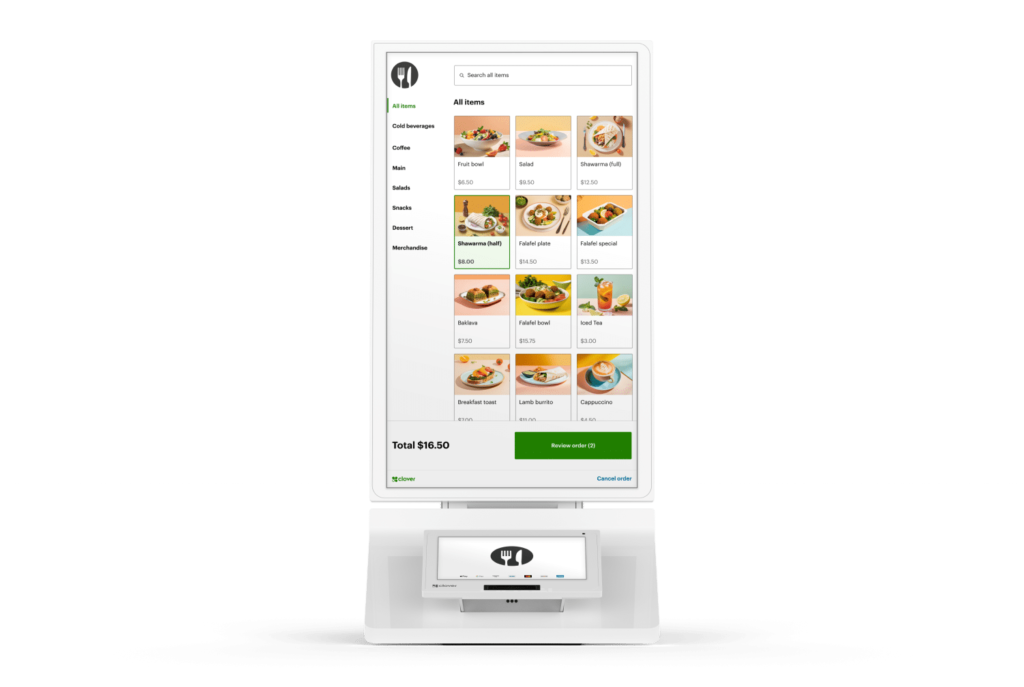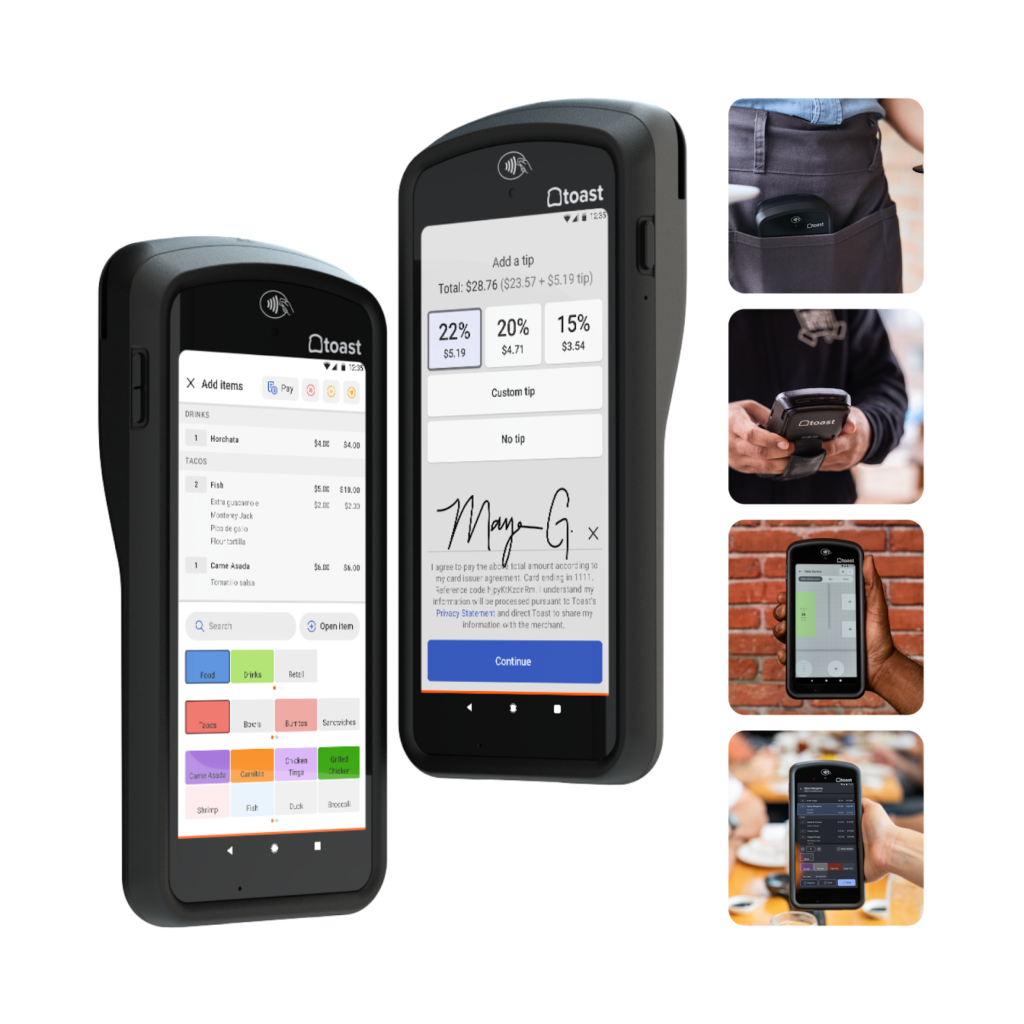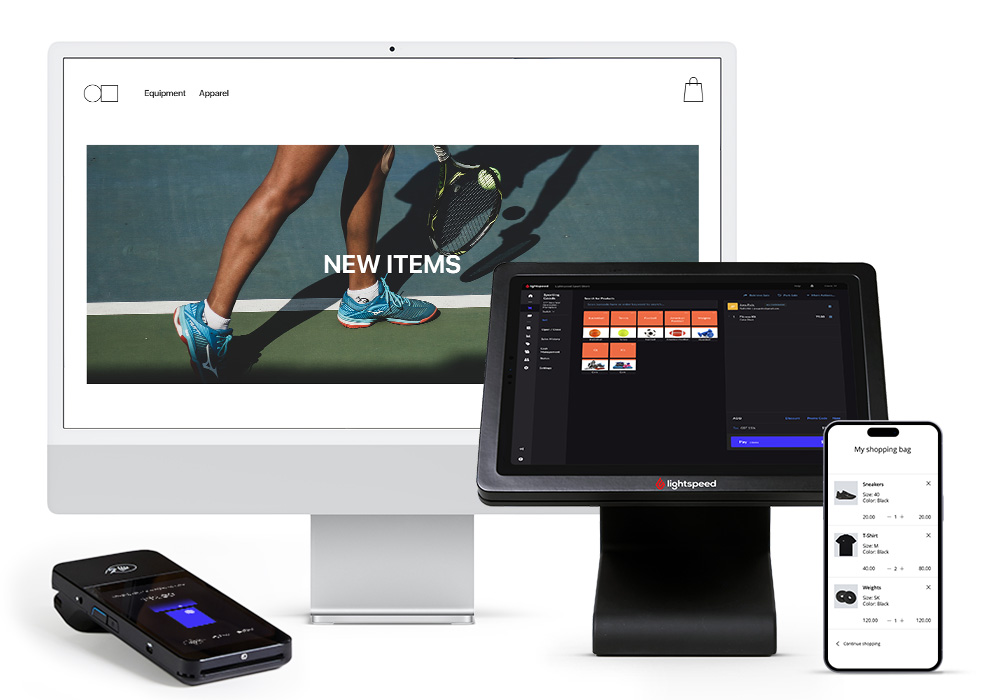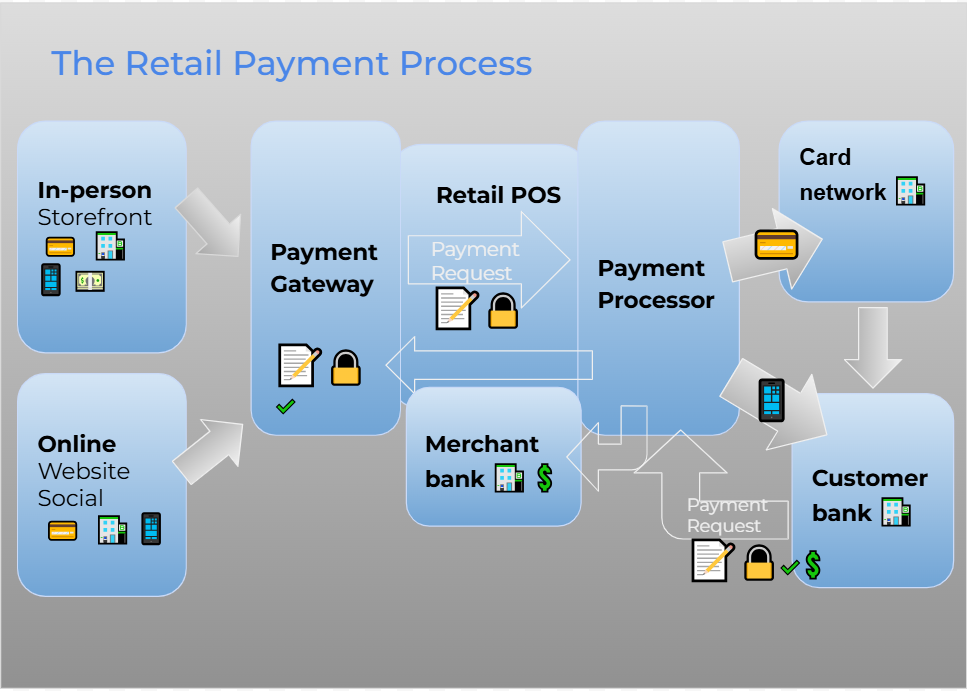Key takeaways
POS is an acronym that stands for point-of-sale system. In short, a POS is a device/software/terminal configuration that facilitates the acceptance and processing of sales transactions, multiple forms of payment (credit cards, debit cards, digital payments, etc.), and the calculation and collection of applicable sales taxes.
Today’s POS system is not your grandfather’s cash register; modern POS systems have evolved into something entirely different. Your POS system is your business’s heart and pumps every enterprise’s cash flow.
Whether it’s a self-service kiosk, online POS system, terminal POS system, tablet-based POS system, mobile POS system, multi-channel, or open-source POS system, there are a multitude of types of POS systems to choose from that can be tailored to your unique needs, budget, and customer base. In short, the right POS system type and approach will best suit your individualized needs and demands.
Following are some of the most common types of POS systems found in small businesses today.
Self-service POS kiosks
This type of POS system is designed to provide convenience and speed for the customer, reduce labor costs, and free employees to perform other functions. These are most popular and used at many fast-food or casual dining restaurants and other self-service businesses — gas stations, bank ATMs hotels, hospital check-ins, retailers, etc.

Pros of self-service kiosks
The obvious pros of using self-service kiosks are reductions in labor, expediting of the transaction and ordering process, preventing bottlenecks in placing orders or making purchases, reducing labor overhead and other associated costs (health insurance, worker’s comp costs), 24/7 operation, increased customer satisfaction, a reduction in order or communication errors, a reduction in paper receipts and ink costs, and the elimination of duplicate methods of order taking (orders are sent digitally to kitchen, counter, or waitstaff). It’s also an opportunity to market and upsell a customer quickly and non-intrusively.
Cons of self-service kiosks
The cons are few, but some customers still prefer someone to wait on them and enjoy human interactions or are intimidated by ordering via machines.
This option is growing in popularity and is used by numerous enterprises, but it is still one of seven different point of sale systems that may be the best fit for your business.
Read more: How to use a POS system
Mobile point of sale systems
As the name implies, these POS systems work via smartphones. Typically, the POS provider provides the merchant with a simple small scanner that plugs into the merchant’s smartphone or tablet, and the software to run the POS solution is typically free. The POS solution provider also normally charges a percentage of each solution.

Expert Tip
This solution is perfect for users who need to be mobile and untethered to a terminal or storefront. Mobile POS is also an excellent solution for food or street vendors, festivals, events, merchandise sales, concerts, lawn care companies, landscapers, freelancers, artists, etc.
Pros of mobile POS systems
The pros to these systems are they typically don’t require contracts, POS hardware (just a tiny card reader), or tethered terminals. While these POS providers take a small percentage of sales, they don’t have any recurring fees or long-term agreements.
Cons of mobile POS systems
There really aren’t many cons to a mobile setup. However, depending on your business size, you may want to use mobile systems in addition to more robust countertop terminals.
Tablet POS systems
Like mobile point of sales solutions and tablet POS systems that work with iPads (iOS) and Android-type tablets, like mobile POS solutions, they are portable or can also be used at a fixed retail location but allow more flexibility and mobility. Some types of POS systems charge a monthly or recurring fee, and others provide free software but charge a processing fee.
This may be an excellent solution for retailers, merchants, food and beverage vendors, small restaurants, coffee houses, cafes, juice bars, and other small retailers, hair salons, or commercial retailers.

Pros of tablet POS systems
Pros of the tablet POS option include mobility and the ability to add more hardware or peripherals, including barcode scanners, receipt printers, cash drawers, and static table stands. You can also perform inventory control and timecard tracking tasks.
Cons of tablet POS systems
Depending on your business environment, a standard Apple or Android tablet might not be durable enough to meet your needs. Restaurants, for example, will likely want a system built to withstand high heat, humidity, grease, and drops.
Also, consider what other apps and functions will be accessible on the tablet and whether or not that is a concern. For example, a medical practice or spa might not want tablets that come with pre-programmed cameras, for example.
Also read: POS Data Guide for POS Analytics
Online POS sale solutions
This is an easy-to-use and low-cost POS solution or option because you can use existing hardware, tablets, laptops, or desktop computers to process your transactions, including high-ticket transactions. This may be the perfect solution for any merchant that doesn’t do high-volume, high-frequency sales; plus, just like mobile and tablet POS solutions, you can log in anywhere where you can access the internet or Wi-Fi.

This may be a great option if you’re a small retailer, salon, art gallery, consignment store, antique store, etc.
Pros of online POS systems
With online POS software, businesses can reach customers who are unable to visit a brick-and-mortar store. All online POS software is accessible via a secure web browser, so there is no need to purchase special hardware or pay for additional licenses as with traditional POS systems that can rack up expensive upfront investment costs. Most online POS software, like Shopify, can also be used for a countertop setup if you want to sell in-person.
Cons of online POS systems
Most online POS systems are not stand-alone. They are often included in separate ecommerce or traditional POS plans, both of which may require a paid monthly subscription. You can find a free stand-alone solution, although the features are likely basic and will need a paid plan upgrade to access better functionalities. Online POS systems are also dependent on internet connection, so you will end up missing out on potential sales without it.
Multichannel POS systems
A multichannel POS system is a scalable point-of-sale system that integrates and manages sales across multiple sales channels within an enterprise. The most significant advantage of this POS type is the ability to consolidate all transactions, inventory management (reflecting real-time updates to stock levels), order management, and unified enterprises with an omnichannel sales approach — retail mortar sales, pickup, delivery, e-commerce, etc.

Pros of multichannel POS systems
Multiple sales channels mean reaching more customers. The system is primarily cloud-based, so all data, including inventory, is available in real time. A multichannel POS system is often characterized by a well-developed inventory management feature and a wide range of business integration tools, such as stock management, fulfillment, marketing, and more.
Cons of multichannel POS systems
One thing about a multichannel POS system is that it tries to do everything, including payments. You will likely be locked into the POS system’s ecosystem for software and payments. If this happens, the potential to scale your business will depend on the POS system’s capabilities, and you won’t be able to shop around for lower processing fees.
Open-source POS systems
First, let’s establish what the term open source means; this term refers to software or projects that use a source code that’s widely and freely available to everyone for viewing, enhancement, modification, and even distribution. This kind of POS option allows individuals, communities, and organizations to easily collaborate, improve, modify, and build upon the original framework.
If you have the technical knowledge and experts on staff and demand the most open-source POS option, this might be the perfect solution for your business, but there will be better fits for most companies.

Pros of an open source POS
The main advantage of an open-source POS system is flexibility and control. With the right developer tools, there is simply no limitation when it comes to customized upgrades. You can choose from different POS hardware providers and payment processors to find the best rates based on your sales volume. The result is a POS system tailored exactly to your business needs.
Cons of an open source POS
Because the software is open source, there’s typically little support. You must rely on the “community” and others to troubleshoot issues. This will require technical expertise and skills to configure, maintain, and troubleshoot. Additionally, as with proprietary (paid) software, open-source POS software can also face vulnerabilities. You must actively monitor security breaches and updates and apply patches promptly.
An open source POS system also lacks built-in features and will not seamlessly integrate with other proprietary solutions. You will have to develop everything that you need, thus incurring potential additional costs and labor needs. If you run into issues, there’s no conventional customer support, and you may need to outsource this task or hire your own team or individual. This can add to labor costs and overhead, plus make you dependent on “experts.”
Terminal POS systems
A Terminal POS is a traditional type of POS for retailers. This is still a popular and relatively prevalent configuration or POS solution that has a hardware device (typically fixed) and is the physical “interface” for transactions between a merchant and a customer. Terminal POS systems integrate well with other business software, including accounting, inventory, CRM, and data management. These types of POS systems generate printed receipts, including sale details.

Most terminal POS systems use hardware/terminal (touchscreen), keypads, software, card readers, inventory management, receipt generation, and other peripherals or hardware.
This is a great POS system for retailers and larger enterprises that are typically more “tethered” to a physical location with checkout lanes, etc.
Read more: Best POS for Customer Rewards
Pros of a terminal POS system
A POS terminal is reliable and built to withstand processing thousands of sales transactions every day. POS hardware is widely available, so there is no issue searching for compatible peripherals to upgrade the countertop setup. The software is designed to share data within the closed network, so it’s easy to expand into more lanes sharing the same inventory and sales data.
Cons of a terminal POS system
The biggest disadvantage of using a terminal POS is the cost. The upfront investment in software licenses, hardware, and one-time set-up fees will cost hundreds of dollars. While most users are familiar with the configuration, specific functionalities can differ significantly, so employees using the system will require some level of training to maximize their use of the software.
Expert Tip
Smart Terminals: are an increasingly popular POS option. Unlike traditional tethered terminals, smart terminals are mobile, touchscreen POS devices. In recent years, popular POS providers like Square, PayPal, and Clover have broadened their smart terminal offerings. In fact, most of our recommended card readers are actually smart terminals.
Key POS Features
Every kind of POS system comes with basic features that allow businesses to process daily transactions. What makes a POS software unique from a cash register is the set of business management tools integrated into the POS. This integration streamlines the daily business operations and makes real-time business reporting possible.
Below are some examples:
Basic POS Features
Advanced POS Features
- POS register/checkout
- Cash tracking
- Basic inventory
- CRM
- Employee management
- Marketing
- Loyalty program
- Employee management
Aside from the basics, most types of POS systems offer even more advanced features such as industry-specific inventory tools, a native website builder, and order fulfillment capabilities.
Learn more: Key POS features
The future of POS solutions
We don’t claim to have a crystal ball, especially when it comes to predicting the future of POS, but a few trends or indicators are clear:
The adoption of Tablet and Mobile POS systems will accelerate due to increased market penetration, consumer demands and behavior, reductions in price, more flexibility, and the anywhere-anytime qualities of these two solutions.
How do you select the right POS for your business?
If you’ve read this far, thank you. As you may already be able to see, there are many options out there, and there are a lot of considerations to make when selecting a POS system solution for your business or enterprise.
We hope our quick analyses and brief overviews point you in the right direction, eliminate specific unsuitable POS systems or approaches, and find the perfect POS solution that meets all your demands, future needs, and budget.
Check out our Retail Point-of-Sale Buyer’s Guide to help you along your journey.





